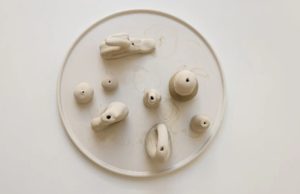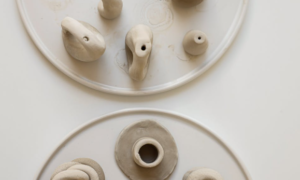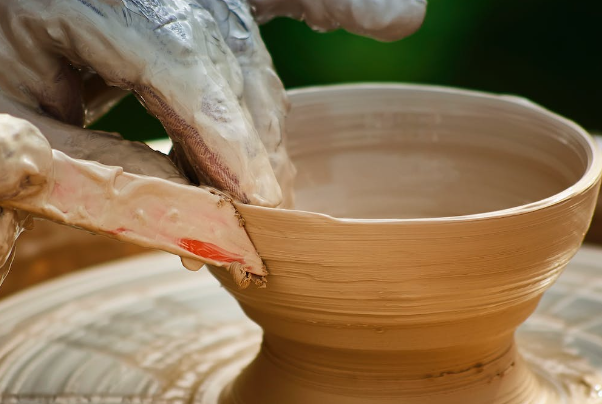Table Of Contents
- 1 Unveiling the World of Abstract Clay Sculpting
- 1.1 Defining Abstract Clay Sculpting
- 1.2 Benefits of Abstract Clay Sculpting
- 1.3 Essential Materials for Abstract Clay Sculpting
- 1.4 Basic Techniques for Beginners
- 1.5 Finding Inspiration and Developing Ideas
- 1.6 Deep Dive into Techniques
- 1.7 Coiling and Pinching: The Foundations of Abstract Clay Sculpting
- 1.8 Coiling Technique:
- 1.9 Pinching Technique:
- 1.10 Slabbing and Scoring: Creating Flat Forms and Joining Pieces
- 1.11 Slabbing Technique:
- 1.12 Scoring and Slip: Secure Joining
- 1.13 Using Textures and Impressing: Adding Dimension and Character
- 1.14 Textures:
- 1.15 Impressing:
- 1.16 Exploring Advanced Techniques and Styles
- 1.17 Building Armatures and Supports:
- 1.18 Hollowing Out and Reducing Weight:
- 1.19 Enrobes and Glazes for Color and Texture:
- 1.20 Firing Techniques:
- 1.21 Troubleshooting and Common Mistakes:
- 1.22 Conclusion and FAQs
- 1.23 Conclusion:
- 1.24 FAQs:
- 1.25 What are the best clays for abstract clay sculpting?
- 1.26 What are some resources for learning about abstract clay sculpting?
- 1.27 How can I store my abstract clay sculptures?
- 1.28 What are some common themes or subjects explored in abstract clay sculpting?
- 1.29 How can I share my abstract clay sculptures with others?
Unveiling the World of Abstract Clay Sculpting
Embark on a creative journey into the realm of abstract clay sculpting, where imagination reigns supreme and form transcends the boundaries of representation. This captivating art form offers a unique platform for self-expression, allowing you to explore the boundless possibilities of shaping and transforming clay into captivating three-dimensional forms.
Defining Abstract Clay Sculpting
Abstract clay sculpting, as the name suggests, departs from the traditional depiction of recognizable objects or figures. Instead, it embraces the language of form, texture, and color to convey emotions, ideas, and abstract concepts. This artistic exploration frees you from the constraints of realism, allowing you to delve into the realm of personal interpretation and evoke a sense of wonder and intrigue in viewers.
Benefits of Abstract Clay Sculpting
The allure of abstract clay sculpting lies in its ability to ignite creativity and foster personal growth. Here are some of the key benefits of engaging in this art form:
-
Unleashing Creativity: Abstract clay sculpting provides an open canvas for self-expression, encouraging you to explore your imagination and challenge conventional artistic norms.
-
Developing Fine Motor Skills: Working with clay demands precision and control over your hands and fingers, subtly improving fine motor skills and coordination.
-
Enhancing Focus and Mindfulness: The meditative process of shaping and molding clay can promote focus, mindfulness, and a sense of calm amidst the hustle and bustle of daily life.
-
Emotional Expression: Abstract clay sculptures can serve as a powerful medium for expressing emotions, thoughts, and experiences that may be difficult to articulate in words.
-
Artistic Growth: Experimenting with different techniques, textures, and colors allows you to expand your artistic horizons and refine your sculpting skills.
Essential Materials for Abstract Clay Sculpting
Before embarking on your abstract clay sculpting journey, ensure you have the necessary tools and materials:
-
Ample Clay: Opt for a non-toxic, high-quality clay that is easy to manipulate and suitable for firing.
-
Tools: A basic set of sculpting tools, including a variety of sculpting knives, rib tools, and loop tools, will provide the versatility to create diverse forms.
-
Working Surface: A smooth, non-porous surface, such as a plaster-covered board or a glass tabletop, is ideal for sculpting.
-
Water: A spray bottle filled with water is essential for keeping the clay moist and preventing it from drying out too quickly.
-
Glaze or Engobe: Glazes provide a glossy or matte finish, while engobes offer a muted, earthy color palette.
-
Kiln: A kiln is used to fire the clay, transforming it from a soft, malleable material into a durable, permanent sculpture.
Basic Techniques for Beginners
As you delve into the world of abstract clay sculpting, these foundational techniques will serve as your building blocks:
-
Coiling: This technique involves rolling out coils of clay and attaching them to form a sculpture.
-
Pinching: This method involves shaping clay by pinching and molding it between your fingers.
-
Slabbing: This involves flattening a slab of clay and creating forms by cutting, carving, and joining pieces together.
-
Scoring and Slip: Scoring involves creating shallow lines in the clay to facilitate joining pieces together. Applying slip, a thin liquid clay, further strengthens the bond.
-
Textures and Impressing: Use tools, textures, or natural objects to create unique surface patterns and textures on your sculpture.
Finding Inspiration and Developing Ideas
Abstract art thrives on inspiration and creativity. Here are some tips for sparking your imagination and generating ideas for your sculptures:
-
Explore Nature: Observe the shapes, textures, and patterns found in nature, from the intricate details of leaves and flowers to the swirling formations of clouds and rocks.
-
Delve into Art Books and Galleries: Visit museums and art galleries to immerse yourself in the world of abstract art, drawing inspiration from the works of renowned artists and contemporary creations.
-
Experiment with Different Elements: Combine various materials, such as found objects, beads, or feathers, to incorporate unique elements into your sculptures.
-
Embrace Abstract Concepts: Explore abstract concepts such as emotions, memories, and philosophical ideas, translating them into tangible forms through your sculptures.
-
Challenge Your Perspective: Step outside your comfort zone and experiment with unconventional forms, textures, and colors.
**Ready to embark on your abstract clay sculpting journey? Join me in the next session as we delve into the intricacies of specific techniques, exploring the world of coils, slabs, and textures.

Deep Dive into Techniques
Coiling and Pinching: The Foundations of Abstract Clay Sculpting
Coiling and pinching are two fundamental techniques that serve as the building blocks for many abstract clay sculptures. These techniques provide a versatile foundation for creating diverse forms and textures, allowing you to transform clay into captivating three-dimensional pieces.
Coiling Technique:
-
Roll out coils of clay: Using a rolling pin or your fingers, create even-sized coils of clay. The thickness and diameter of the coils will influence the overall form and texture of your sculpture.
-
Attach the coils: Start by creating a base for your sculpture. Begin attaching the coils, overlapping them slightly to create a seamless surface. Use slip to adhere the coils firmly together.
-
Form the sculpture: Continue attaching coils, gradually shaping the sculpture according to your desired form. Adjust the coils, adding or removing them as needed to achieve the desired shape and dimensions.
-
Refine and smoothen: Once the basic form has been established, use your fingers or sculpting tools to refine the edges, smoothen the surface, and create any desired details or textures.
Pinching Technique:
-
Create a ball of clay: Start with a ball of clay, molding it into a smooth, even shape. The size of the ball will determine the size of your sculpture.
-
Pinch and form: Use your fingers to pinch and form the clay, gradually shaping it into the desired form. Apply pressure and tension to create varied textures and surfaces.
-
Enhance the form: Use sculpting tools to add details, refine edges, and create unique textures. Experiment with different tool types and techniques to achieve your desired results.
Slabbing and Scoring: Creating Flat Forms and Joining Pieces
Slabbing and scoring are essential techniques for creating flat forms and joining pieces in abstract clay sculpting. These techniques allow for precise shaping and secure attachments, enabling the creation of intricate and complex sculptures.
Slabbing Technique:
-
Knead the clay: Knead the clay until it is soft and pliable. This will make it easier to flatten and manipulate.
-
Roll out a slab: Using a rolling pin or your hands, roll out a slab of clay to the desired thickness. The thickness will influence the overall strength and stability of your sculpture.
-
Cut and shape: Use sculpting tools or a sharp knife to cut the slab into desired shapes or forms. Experiment with different cutting techniques to create unique textures and edges.
Scoring and Slip: Secure Joining
-
Create shallow lines: Use a sculpting tool to create shallow lines or grooves on the edges of two pieces of clay that you want to join.
-
Apply slip: Apply a thin layer of slip to the scored lines or grooves on both pieces of clay. The slip will act as a bonding agent, ensuring a strong connection.
-
Join the pieces: Press the two pieces of clay together firmly, ensuring that the scored lines align and the slip is evenly distributed.
Using Textures and Impressing: Adding Dimension and Character
Textures and impressing techniques are valuable tools for adding visual interest and depth to your abstract clay sculptures. These techniques can transform smooth surfaces into unique and captivating forms.
Textures:
-
Use sculpting tools: Create textures by dragging or pressing sculpting tools over the surface of the clay. Vary the pressure and tool types to create a variety of textures.
-
Incorporate natural objects: Use found objects, such as leaves, bark, or fabric, to press onto the clay, creating unique imprints and patterns.
-
Embellish with tools: Use sculpting tools to carve, score, or indent the clay, adding subtle details and textural variation.
Impressing:
-
Use stamps or molds: Create textures by pressing stamps, molds, or even household objects onto the clay. Experiment with different patterns and motifs.
-
Create unique textures: Combine various imprinting methods and techniques to create a variety of textures and patterns.
-
Embrace randomness: Allow the textures to flow freely, without being overly precise or controlled. Embrace the serendipitous beauty of spontaneous marks and impressions.

Exploring Advanced Techniques and Styles
Building Armatures and Supports:
Creating complex or large-scale sculptures often requires the use of armatures or supports to provide structure and stability. These internal structures ensure the integrity of the sculpture during the sculpting process and prevent it from collapsing.
Hollowing Out and Reducing Weight:
Hollowing out portions of a sculpture can significantly reduce its weight, making it easier to handle and transport. This technique is particularly useful for creating lightweight sculptures that can be displayed in various settings.
Enrobes and Glazes for Color and Texture:
Engobes and glazes are specialized clay mixtures that can be applied to the surface of dried clay sculptures to add color, texture, and vibrancy. Engobes provide a matte finish, while glazes offer a glossy or textured appearance.
Firing Techniques:
The firing process transforms the malleable clay into a durable, permanent sculpture. Different firing techniques, such as pottery kilns or gas kilns, are used to achieve specific effects and properties, such as vitrification (full fusion) or bisque firing (part fusion).
Troubleshooting and Common Mistakes:
As you embark on your abstract clay sculpting journey, you may encounter challenges and common mistakes. Here are some tips for troubleshooting and avoiding pitfalls:
-
Over-working the clay: Avoid over-working the clay, as this can make it dry out and crack. Use tools sparingly and work with damp hands to preserve the clay’s moisture.
-
Not enough slip: Adequately applying slip when joining pieces of clay is crucial for ensuring a strong and secure bond. Use a thin layer of slip to prevent the clay from sticking and cracking.
-
Under-drying or over-drying: Ensure the clay is properly dried before firing. Under-drying can lead to warping or cracking during firing, while over-drying can make it brittle and difficult to sculpt.
-
Uneven firing: Even firing is essential for achieving a consistent and durable sculpture. Use a kiln with a reliable heating and cooling cycle to ensure even heating throughout the firing process.
-
Experiment and learn from your mistakes: Don’t be afraid to experiment and try new techniques. Every piece is an opportunity to learn and improve your skills. Embrace mistakes as learning opportunities and use them to refine your technique.
Conclusion and FAQs
Conclusion:
Abstract clay sculpting offers a boundless realm of creative possibilities, allowing you to express your imagination and explore the language of form, texture, and color. As you delve into this captivating art form, embrace experimentation, challenge your perspectives, and let your creativity flow freely.
FAQs:
What are the best clays for abstract clay sculpting?
There are various clays suitable for abstract clay sculpting, each with its unique properties and characteristics. Consider factors such as plasticity, drying time, and suitability for firing when making your choice.
What are some resources for learning about abstract clay sculpting?
Numerous resources are available to guide you in your abstract clay sculpting journey. Books, online tutorials, and workshops from experienced artists can provide valuable insights and techniques.
How can I store my abstract clay sculptures?
Store your abstract clay sculptures in a cool, dry place to prevent them from cracking or warping. Avoid direct sunlight, excessive humidity, or extreme temperatures.
What are some common themes or subjects explored in abstract clay sculpting?
Abstract clay sculptors often explore themes of nature, emotion, movement, and the human experience. The possibilities are endless, as artists translate their unique perspectives and interpretations into tangible forms.
Consider displaying your abstract clay sculptures in art galleries, local exhibitions, or online platforms. Share your work with fellow artists and enthusiasts to expand your artistic community and connect with like-minded individuals.
